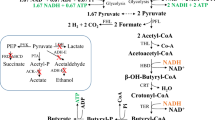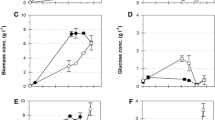Summary
The productivity ofEscherichia coli biomass and recombinant beta-galactosidase was increased in Luria broth (LB) enriched with yeast extract. In flask culture under conditions of LB limitation, yeast extract suplementation gave the highest biomass (strain HB101/pRW756) stimulation per unit of component added compared with supplementation by various amounts of amino acids, vitamins, minerals, purines/pyrimidines, tryptone, casamino acids, casein peptone or gelatin peptone. The biomass production ofE. coli HB101/pRW756, XL-1 blue/puc118, XL-1 Blue FF/puc118 and TB-1/p1034 cells was stimulated in fermentor-scale experiments with additional yeast extract in LB. Total beta-galactosidase production from plasmid genes in fermentor-scale experiments was increased 105.4% in XL-1 blue/puc118 cells, 365.5% in XL-1 blue FF/puc118 cells and 421.4% in TB-1/p1034 cells by 0.5%, 1% and 1% weight per volume of additional yeast extract in LB, respectively. Depending on different strains, the increase of the enzyme production was obtained either by increased biomass, or the combination of enhanced gene expression and increased biomass. Neither the biomass nor beta-galactosidase production was stimulated in N4830/p1034 cells by the increase in yeast extract concentration in the medium.
Similar content being viewed by others
References
Beckwith, J.R. 1964. A deletion analysis of the lac operator region inEscherichia coli. J. Mol. Biol. 8: 427–430.
Bremer, H. and P.P. Dennis. 1987. Modulation of chemical composition and other parameters of the cell by growth rate. In:Escherichia coli andSalmonella typhimurium, cellular and molecular biology (Frederick C. Neidhardt, ed.), pp. 1527–1542, American Society for Microbiology, Washington, DC.
Bullock, W.O., J.M. Fernandez and J.M. Short. 1987. XL-1 Blue: a high efficiency plasmid transforming recAEscherichia coli strain with beta-galactosidase selection. Biotechniques 5: 376–379.
Cho, SungAe, S. Scharpf, M. Franko and W.C. Vermeulen. 1985. Effect of iso-propyl-thio-β-d-galactoside concentration on the level of lac operon induction in steady stateEscherichia coli. Biochem. Biophys. Res. Commun. 128: 1268–1273.
Gottesman, M.E., S. Adhya and A. Das. 1980. Transcription antitermination by bacteriophage lambda N gene product. J. Mol. Biol. 140: 57–75.
Maniatis, T., E.F. Fritsch and J. Sambrook. 1982. TransformationEscherichia coli by plasmid DNA. In: Molecular Cloning, pp. 249–253, Cold Spring Harbor Laboratory.
Rechcigl, M., Jr. 1978. Section G. In: Handbook Series in Nutrition and Food, Volume III, pp. 91–119, CRC Press, Inc., Ohio.
Reznikoff, W. and L. Gold. 1986. Response of protein levels to copy number. In: Maximizing gene expression, pp. 354–355, Butterworth Publishers, MA.
Robbins, J.W., Jr. and K. B. Taylor. 1987. Optimization ofEscherichia coli growth by controlled addition of glucose. SIM News, Vol. 36, No. 4, p. A17.
Schleif, R.F. and Pieter C. Wensink. Enzyme assays. In: Practical methods in molecular biology, pp. 43–45, Springer Verlag, New York. Heidelberg, Berlin.
Tsai, L.B., M. Mann, F. Morris, C. Rotgers and D. Fenton. 1987. The effect of organic nitrogen and glucose on the production of recombinant human insulin-like growth factor in high cell densityEscherichia coli fermentation. J. Industrial Microbiol 2: 181–187.
Ullman, A., F. Jacob and J. Monod. 1967. Characterization by in vitro complementation of a peptide corresponding to an operator proximal segment of the beta-galactosidase structural gene ofEscherichia coli. J. Mol. Biol. 24: 339–343.
Weber, A.E. and Ka-Yiu San. 1987. Persistence and expression of the plasmid pBR322 inEscherichia coli K12 cultured in complex medium. Biotech. Lett. 9: 757–760.
Yanisch-Perron, C., J. Vieira and J. Messing. 1985. Improved M13 phage cloning vectors and host strains: nucleotide sequences of the M13mp18 and puc19 vectors. Gene 33: 103–119.
Zipser, D. and P. Bhavsar. 1976. Missense mutations in thelacZ gene that result in degradation of beta-galactosidase structure in protein. J. Bacteriol 127: 1538–1543.
Author information
Authors and Affiliations
Rights and permissions
About this article
Cite this article
Li, X., Robbins, J.W. & Taylor, K.B. The production of recombinant beta-galactosidase inEscherichia coli in yeast extract enriched medium. Journal of Industrial Microbiology 5, 85–93 (1990). https://doi.org/10.1007/BF01573857
Received:
Revised:
Accepted:
Issue Date:
DOI: https://doi.org/10.1007/BF01573857




